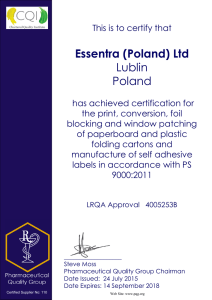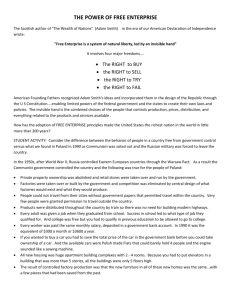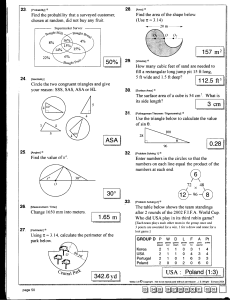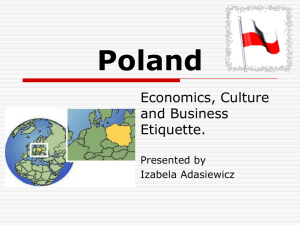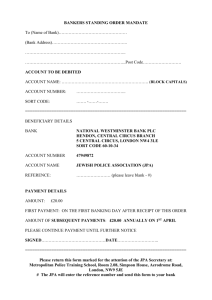JELB Power Associates Inc. 1
advertisement
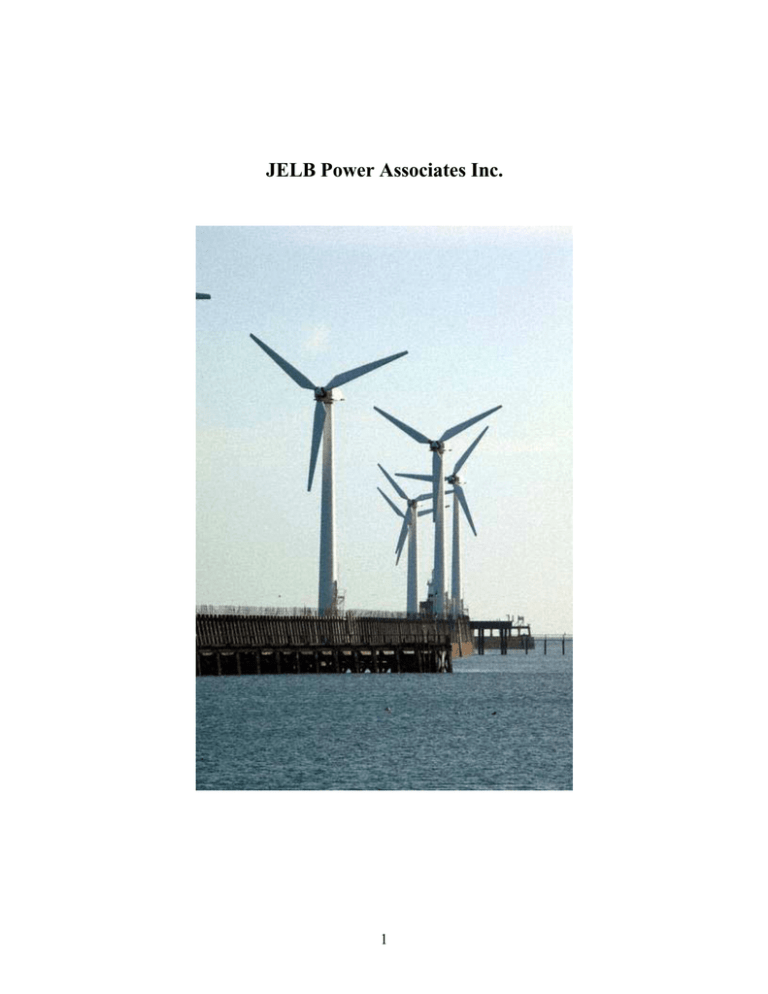
JELB Power Associates Inc. 1 JELB Power Associate s Request for Proposal (RFP) for Wind Power Generation in Poland ! Our Company ! Project Scope ! Project Background o o o o o o Current Energy Resources Political Environment Economic Situation Current Tax Status Tax Incentives Average Labor Costs ! Joint Venture Organization ! Joint Venture Financial Aspects ! Proposal Delivery Terms o Project Specifications o Future Developments ! Proposal Deliverables 2 Our Company JELB Power Associates Inc. (JPA) is a well-established energy provider in Poland. JPA currently operates three fossil (coal fired) power plants in Northern Poland, with a total capacity of 900 MW. In light of new emerging markets for renewable energy plants, JPA would like to be one of the first companies to benefit from the wind power market in Poland, and possible in other countries in Eastern Europe. In addition to operating three power plants, JPA also has an extensive engineering department. The main purpose of the engineering department is to evaluate cleaner burning solutions for our current power plants. While our engineering department is relatively new, three years old, an experienced group manages it. Our top officers are as follows: Emerson Chin --- CEO Bryant NG --- CFO Leroy Li --- CTO Jackie Burke --- Human & Country Relations In order to ensure the success of this project JPA would make this venture the highest priority for the engineering department and its officers. Project Scope To establish a joint-venture with a qualified, well established partner, for the construction, operation, and electric energy marketing of a 15 MW capacity wind power farm in the north of Poland. JELB Power Associates Inc. seeks to enter into a joint venture with an internationally recognized firm, with expertise and experience in the wind power generation. The qualified company should meet the following criteria: • • • • Expertise in the design of wind farms. Strong skills in economic analysis of project. Capability to offer a turnkey solution, design and build. Wind generated energy marketing experience JPA Inc. is prepared to offer their knowledge of current local laws and customs, financial expertise, and any supportive engineering, construction, and management services required to assist the JV partner. 3 Project Background Current Energy Resources The Polish power generation sector has a total installed capacity of more than 33,000˚MW. However majority of the plants are thermal power plants, with 97% of them coal fired and the rest relying on the combustion of natural gas and oil. Hydroelectric power plants account for 7% of the generating capacity. 1.2% 0.2% 11.4% 20.9% 66.3% Coal Oil Natural Gas Hydroelectric Other The figure above shows the breakdown of Poland s usage of its primary energy resources. The public power generation sector primarily consists of 55 thermal power plants, 33 of which are combined heat and power plants. More than half of the current capacity was constructed in the 1970 s. Approximately 60% of the system is more than 15 years old and 40% is more than 20 years old. Therefore, many of Poland s major power plants are approaching their predicted lifetimes, causing great concern in the future of Poland s electricity generation. In addition, the Polish government has imposed strict environment guidelines, requiring efficiency increases and pollution control. As a result, many of Poland s existing thermal power plants are in desperate need of modernization, requiring huge amounts of capital. Moreover, the growing industry of Poland will require more power generation in the upcoming years. The expected increase in the global economic growth shall lead to increase in demand for energy. The International Coal Report concluded that Poland would need to commission new power plants at a rate of 400 MW per year in the years of 2000-2004. However these new plants will also need to meet the environmental specifications. 4 Poland is seeking to increase its economic growth, yet preserve the condition of the natural environment. A substantial factor in the country s success will be in its energy resources. Therefore, renewable energy is the only right way for the future development of the energy sector. Thus wind turbines on the map of Poland are a new reality. The wind resources are an inexhaustible source of energy, and as much as 75% of Poland’s area have favorable wind conditions, about 5% have very favorable conditions. Wind energy is an invaluable resource that has excellent potential and should be capitalized. Political Environment Poland gained its independence in 1918 only to be overrun by Germany and the Soviet Union in World War II. It became a Soviet satellite country following the war, but one that was comparatively tolerant and progressive. Labor turmoil in 1980 led to the formation of the independent trade union "Solidarity" that over time became a political force and by 1990 had swept parliamentary elections and the presidency. A "shock therapy" program during the early 1990s enabled the country to transform its economy into one of the most robust in Central Europe, boosting hopes for acceptance to the EU. Poland joined the NATO alliance in 1999. This is a significant fact in the light of the European Union’s expectations regarding the 12% share of renewable energy sources in the energetic balance of the country applying for EU membership. Environmental situation has improved since 1989 due to decline in heavy industry and increased environmental concern by post communist governments; air pollution nonetheless remains serious because of sulfur dioxide emissions from coal-fired power plants, and the resulting acid rain has caused forest damage; water pollution from industrial and municipal sources is also a problem, as is disposal of hazardous wastes. Economic Situation Poland has continued to experience good economic growth; the increase in gross domestic product was 4.8% for the year 2000. In 2000, Poland’s foreign debt was $57˚billion. The unemployment rate in 2000 was about 12% and the rate of inflation was 10.2%. An historical summary of Poland’s GDP growth rate and inflation is shown in Table˚1. 5 Table 1: Poland’s GDP and Inflation, 1990-99 Component Annual GDP Growth Rate* (percent) End-of-Year Inflation (percent) 1990 1991 1992 1993 1994 1995 1996 1997 1998 1999 -11.6 -7.0 2.6 3.8 5.5 7.0 6.1 6.9 5.9 3.8 586 70.3 43.0 35.3 32.2 27.8 19.9 14.9 13.0 8.4 In addition to the increase in the GDP, and the reduction of inflation, the Polish Ministry of Economy recently passed an ordinance that makes it mandatory for the Polish Power Grid companies to purchase a certain percentage of energy produced from renewable sources. These economic and political factors make the project economically feasible. Current Tax Status • The corporate income tax rate is 28% in 2001 and will drop to 24% in 2003 and 22% in 2004. Companies without corporation status will be taxed anywhere from 20 to 44%. • Tax depreciation follows a straight-line method and accelerated depreciation may be available in special cases. o DEPRECIATION RATE (percent per year) FOR VARIOUS TANGIBLE FIXED ASSET 10 Technical appliances 14 Internal-combustion engines; metal working machines; plastic, chemical- and food-industry machinery 20 Motor vehicles 30 Computer hardware • Operating losses can be carried forward for three years in three equal deductions. Tax Incentives • Corporations can deduct qualifying investment expenditures from pretax profits for corporate income tax purposes. This deduction is limited to 10 percent in the year the investment was made and 50 percent of the prior year investment limited up to 10 percent of taxable income in that year. 6 • Investment in Special Economic Zones will give companies greater incentives. For a list of the SEZs please visit, http://www.paiz.gov.pl/main/incentives.html ˚ Within SEZ Outside SEZ By 2001 Complete exemption from CIT or PIT for 10 years.50% exemption for the remainder of the zone activity period. Property tax exemption. Possibility of exemption from local taxes. From 2001 Complete exemption from CIT or PIT up to a max. amount of 50% of investment inputs and inputs for creating new employment. Property tax exemption possible. Other forms of assistance (in addition to tax exemptions) of up to 50% of investment inputs and inputs for creating new employment. o Grants for employment of the unemployed: - reimbursing the cost of employee training - up to 50% of costs; - reimbursing the social insurance contributions - up to the level of threefold the minimal salary; - Loans for employers to create new employment - possible redemption of up to 50%; - reimbursement of costs incurred on employing graduates (remuneration + awards + social insurance contributions) - for the period of up to 12 months, or 18 months in case when the reimbursement concerns alternate months; - reimbursement of costs incurred on employing unemployed persons (12 months maximum). Average Labor Costs Position General Manager Chief Engineer R & D Engineer Skilled Machine Operator Worker Wage (per year USD) $ 5,886 $ 2,816 $ 2,092 $ 607 $ 443 Joint Venture Organization In order for this joint venture to be successful JPA feels that a strong management team is essential to the project. We propose a Board of Directors consisting of the following positions: CEO --- JPA CFO --- JV Partner 7 COO --- JPA 2 Technical Experts --- 1 from JPA, 1 from JV Partner These officers will be the chief decision-makers for the project. However, there should be other consultants available to assist the board of directors. At the very least they should include: Representative from lending agency Environmental consultant Marketing strategist Joint Venture Financial Aspects Capital Breakdown Equity 40% Debt 60% 8 Equity Breakdown JELB Power 40% Partner 60% We propose the joint venture to fund 40% of the necessary start-up costs via equity (stocks). The rest 60% will be financed by debt, through bonds issued by the JV. The joint venture issued stock will be divided between JPA and its partner based on our negotiated agreement. Polish law does not allow foreign ownership of strategic sectors, such as energy to exceed 50%. JPA wants to assume 40% of the equity of this JV. Debt would be issued in the form of bonds and can be raised from several different sources, including, but not exclusive to: • • • • • • The World Bank International Finance Corporation (IFC) U.S. Trade and Development Agency (TDA) European Bank for Reconstruction and Development Overseas Private Investment Corporation (OPIC) Local private investors Proposal Delivery Terms Project Specifications The project constitutes the development of a wind power farm with a 15 MW capacity, in Northern Poland along the Baltic Sea Coast. The exact location of the site will be determined after consultation with the joint venture partner. The location of the site must be easily accessible to the electrical power system, which is part of the CENTREL system. Other factors to consider in choosing the site will be noise pollution, usage of land, and aesthetics. The Proposal shall contain at least 2 proposed favorable locations to choose from. 9 Upon selection of the site, the joint venture partner will design and build a suitable wind farm, in accordance to European Wind and Turbine Standards. The operational life span of wind farm should be at least twenty years. The joint venture company will then supervise the construction of the plant until completion. During the construction phase, it would also be required that the joint venture partner provide assistance on training employees in the operation and maintenance of the wind farm. Future Developments The main objective of the joint venture is to construct an operational wind power farm. However, future projects such as additional wind farms, domestic and abroad, are a high possibility. Proposal Deliverables All proposals should be submitted via the GTK-7 web site (www.cooper.edu/GTK-7) no later than November 19, 10 PM EST, USA. Proposals should answer all technical, financial, and managerial points and meet all the specifications set by this request. Any questions can be referred to Mr. Emerson Chin, JV Coordinator, via e-mail at the following address: chin3@cooper.edu For required financial data kindly consult the Project Financial Evaluation Forms on the Resources page of the GTK-7 web site. Thank you for your time and consideration JELB Power Associates Inc. 10
